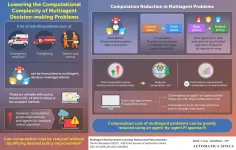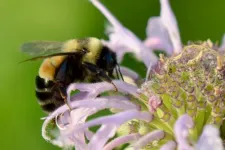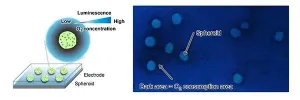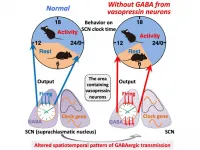A path to graphene topological qubits
Researchers demonstrate that magnetism and superconductivity can coexist in graphene, opening a pathway towards graphene-based topological qubits
2021-04-28
(Press-News.org) In the quantum realm, electrons can group together to behave in interesting ways. Magnetism is one of these behaviors that we see in our day-to-day life, as is the rarer phenomena of superconductivity. Intriguingly, these two behaviors are often antagonists, meaning that the existence of one of them often destroys the other. However, if these two opposite quantum states are forced to coexist artificially, an elusive state called a topological superconductor appears, which is exciting for researchers trying to make topological qubits.
Topological qubits are exciting as one of the potential technologies for future quantum computers. In particular, topological qubits provide the basis for topological quantum computing, which is attractive because it is much less sensitive to interference from its surroundings from perturbing the measurements. However, designing and controlling topological qubits has remained a critically open problem, ultimately due to the difficulty of finding materials capable of hosting these states, such as topological superconductors.
To overcome the elusiveness of topological superconductors, which are remarkably hard to find in natural materials, physicists have developed methodologies to engineer these states by combining common materials. The basic ingredients to engineer topological superconductors - magnetism and superconductivity - often require combining dramatically different materials. What's more, creating a topological superconducting material requires being able to finely tune the magnetism and superconductivity, so researchers have to prove that their material can be both magnetic and superconductive at the same time, and that they can control both properties. In their search for such a material, researchers have turned to graphene.
Graphene - a single layer of carbon atoms - represents a highly controllable and common material and has been raised as one of the critical materials for quantum technologies. However, the coexistence of magnetism and superconductivity has remained elusive in graphene, despite long-standing experimental efforts that demonstrated the existence of these two states independently. This fundamental limitation represents a critical obstacle towards the development of artificial topological superconductivity in graphene.
In a recent breakthrough experiment, researchers at the UAM in Spain, CNRS in France, and INL in Portugal, together with the theoretical support of Prof. Jose Lado at Aalto University, have demonstrated an initial step along a pathway towards topological qubits in graphene. The researchers demonstrated that single layers of graphene can host simultaneous magnetism and superconductivity, by measuring quantum excitations unique to this interplay. This breakthrough finding was accomplished by combining the magnetism of crystal domains in graphene, and the superconductivity of deposited metallic islands.
'This experiment shows that two key paradigmatic quantum orders, superconductivity, and magnetism, can simultaneously coexist in graphene,' said Professor Jose Lado, 'Ultimately, this experiment demonstrates that graphene can simultaneously host the necessary ingredients for topological superconductivity. While in the current experiment we have not yet observed topological superconductivity, building on top of this experiment we can potentially open a new pathway towards carbon-based topological qubits.'
The researchers induced superconductivity in graphene by depositing an island of a conventional superconductor close to grain boundaries, naturally forming seams in the graphene which have a slightly different magnetic properties to the rest of the material. The superconductivity and grain boundary magnetism was demonstrated to give rise to Yu-Shiba-Rusinov states, which can only exists in a material when magnetism and superconductivity coexisting together. The phenomena the team observed in the experiment matched up with the theoretical model developed by Professor Lado, showing that the researchers can fully control the quantum phenomena in their designer hybrid system.
The demonstration of Yu-Shiba-Rusinov states in graphene is the first step towards the ultimate development of graphene-based topological qubits. In particular, by carefully controlling Yu-Shiba-Rusinov states, topological superconductivity and Majorana states can be created. Topological qubits based on Majorana states can potentially drastically overcome the limitations of current qubits, protecting quantum information by exploiting the nature of these unconventional states. The emergence of these states requires meticulous control of the system parameters. The current experiment establishes the critical starting point towards this goal, which can be built upon to hopefully open a disruptive road to carbon-based topological quantum computers.
INFORMATION:
The paper, 'Observation of Yu-Shiba-Rusinov states in superconducting graphene' is published in the journal Advanced Materials https://onlinelibrary.wiley.com/doi/10.1002/adma.202008113
[Attachments] See images for this press release:
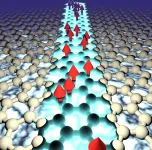
ELSE PRESS RELEASES FROM THIS DATE:
2021-04-28
Even though more and more vaccines against the coronavirus are being administered all over the world, many countries are still battling with outbreaks and face difficulties providing help to those in need.
One of those countries is Brazil. Here, they are facing a massive second wave outbreak, many daily deaths and instances of the health care systems collapsing. In the city of Manaus things have looked exceptionally bleak from December and through to the early spring.
The city was hit so hard by the first wave in 2020 that it was actually thought to be one of the few places in the world to have reached herd immunity. An estimated 75 percent of the population in the city had been infected. But then the second wave ...
2021-04-28
The research team led by Prof. WENG Jianping from University of Science and Technology of China (USTC) of the Chinese Academy of Sciences has implemented a comprehensive preconception-to-pregnancy management plan, namely CARNATION study, for women with type1 diabetes (T1D), to reduce the risks of adverse pregnancy outcomes and improve the pregnancy care since 2015. The study was published in Diabetes Care.
The management plan, approved by the National Health and Family Planning Commission of the People's Republic of China, is made up of the checklist for the relevant health care providers (HCPs) covering 20 items of care in different ...
2021-04-28
Computer scientists often encounter problems relevant to real-life scenarios. For instance, "multiagent problems," a category characterized by multi-stage decision-making by multiple decision makers or "agents," has relevant applications in search-and-rescue missions, firefighting, and emergency response.
Multiagent problems are often solved using a machine learning technique known as "reinforcement learning" (RL), which concerns itself with how intelligent agents make decisions in an environment unfamiliar to them. An approach usually adopted in such an endeavor is policy iteration (PI), which starts off with a "base policy" and then improves on it to generate a "rollout policy" (with the process of generation ...
2021-04-28
CHAMPAIGN, Ill. -- For more than a decade, ecologists have been warning of a downward trend in bumble bee populations across North America, with habitat destruction a primary culprit in those losses. While efforts to preserve wild bees in the Midwest often focus on restoring native flowers to prairies, a new Illinois-based study finds evidence of a steady decline in the availability of springtime flowers in wooded landscapes.
The scarcity of early season flowers in forests - a primary food source for bumble bees at this time of year - likely endangers ...
2021-04-28
WASHINGTON - The Society for Cardiovascular Angiography and Interventions (SCAI) has released an expert consensus statement providing cardiologists, cath lab directors, and hospital leadership guidance for contemporary cath lab standards. The document, "SCAI Expert Consensus Update on Best Practices in the Cardiac Catheterization Laboratory" will be presented today at the SCAI 2021 Virtual Scientific Sessions with simultaneous publication in Catheterization & Cardiovascular Interventions. The statement has been endorsed by the American College of Cardiology Clinical Policy Approval Committee, American Heart Association, ...
2021-04-28
Cells breathe, to an extent, exchanging gases, taking in energy sources from the environment and processing it. Now, researchers from Tohoku University in Japan have shone a light on the process in a new way.
Their demonstrated visualization method in model systems was made available online on March 12th in Biosensors and Bioelectronics, ahead of the June print edition.
The researchers used spheroids - cultured cells within a close-to-natural environment - to mimic a biological tissue using mesenchymal stem cells (MSCs). Due to MCSs' ability to self-renew and differentiate into various ...
2021-04-28
Our bodies and behaviors often seem to have rhythms of their own. Why do we go to the bathroom at the same time every day? Why do we feel off if we can't go to sleep at the right time? Circadian rhythms are a behind-the-scenes force that shape many of our behaviors and our health. Michihiro Mieda and his team at Kanazawa University in Japan are researching how the brain's circadian rhythm control center regulates behavior.
Termed the superchiasmatic nucleus, or SCN, the control center contains many types of neurons that transmit signals using the molecule GABA, but little is known about how each type contributes to our bodily rhythms. In their newest study, the researchers focused on GABA neurons that produce arginine vasopressin, a hormone that regulates ...
2021-04-28
WASHINGTON, D.C, (April 28, 2021) - A new study reveals the use of a potassium ferrate hemostatic patch (PFHP) reduces the time to hemostasis for patients receiving cardiac catherization. The findings indicate a faster approach to removing the compression band used during the procedure, without compromising safety. Positive results of the STAT2 trial follow an initial pilot study and are being presented as late-breaking clinical science at the Society for Cardiovascular Angiography and Interventions (SCAI) 2021 Virtual Scientific Sessions.
Cardiac ...
2021-04-28
WASHINGTON, D.C, (April 28, 2021) - A retrospective analysis of risk factors for coronary artery disease (CAD) in young African American patients is being presented today at the Society for Cardiovascular Angiography and Interventions (SCAI) 2021 Virtual Scientific Sessions. The findings reveal this specific patient segment, African-Americans under age 45, experiences greater CAD risk factors related to smoking, drug and alcohol abuse, HIV as well as mental health conditions including anxiety and depression.
CAD is the most common type of heart disease, with high blood pressure, obstructive sleep apnea and diabetes among traditional risk factors. African Americans are disproportionally ...
2021-04-28
WASHINGTON, D.C., (April 28, 2021) - Results from a retrospective observational study, presented today at Society for Cardiovascular Angiography and Interventions (SCAI) 2021 Virtual Scientific Sessions, reveal a 70% decline in the number of patients presenting with acute myocardial infarction (AMI) during April 2020 compared to April 2019. While the number of patients with AMI seeking care at hospitals dropped during the pandemic, those that did receive care experienced more severe symptoms because of delays in patients seeking emergency services.
AMI, commonly recognized as a heart attack, is responsible for more than one million deaths in the U.S. every year. For the best patient outcomes, seeking care within the ...
LAST 30 PRESS RELEASES:
[Press-News.org] A path to graphene topological qubits
Researchers demonstrate that magnetism and superconductivity can coexist in graphene, opening a pathway towards graphene-based topological qubits

